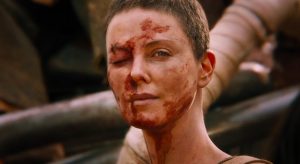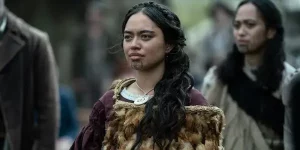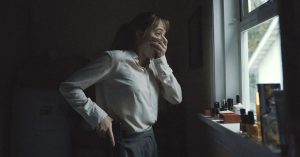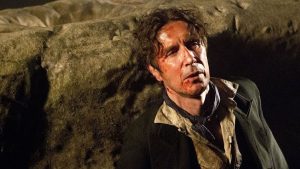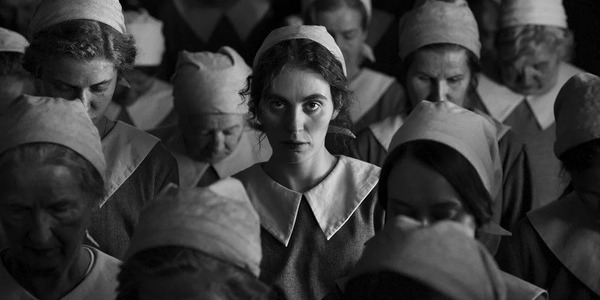
The first two films screening in competition at this year’s edition of the Cannes Film Festival exemplify the harsh realities of womanhood, both past and present, in creatively vibrant narratives that are worthy of praise. Magnus von Horn‘s The Girl with the Needle and Agathe Riedinger‘s Wild Diamond are two vastly different films, but both mange to illustrate the depths of effective storytelling in a modern way.
The Girl with the Needle (Magnus von Horn)
The Girl with the Needle (2024) – source: Cannes Film Festival
With haunting fervour and delectable narrative ambiguity, The Girl with the Needle (Pigen Med Nålen) seethes as a horror-esque film. Shot in black and white, and housing one of the darkest reveals in recent memory, Magnus von Horn shines in what is certainly one of the more impressive films in competition at this year’s Cannes Film Festival.
Based on true events, The Girl with the Needle is set in Copenhagen at the conclusion of World War 1. Karoline (Vic Carmen Sonne), finds herself pregnant and abandoned by her factory manager (Joachim Fjelstrup), with whom she had a brief relationship with. As her husband (Besir Zeciri) – who she thought was deceased during the war – returns as a disfigured man, she involves herself with an underground adoption agency run by Dagmar (Trine Dyrholm). What transpires is an intriguing tale that enters some of the darkest depths of Denmark’s history.
Right from the start, the film’s ominous tone creates a canvas that is marked by von Horn’s unflinching style of storytelling. Events depicted in the film start off in a darkened reality, and continue to descend as the story free falls into even darker territories, which is stylistically complemented by hints of the supernatural. While never devolving into true horror territory, von Horn certainly dances around horror elements while depicting the harrowing world inhabited by the film’s characters. His ability to blend the terrifying realism of post-war Denmark with motifs of a horror film is remarkable, and helps elevate the film to new heights.
By mirroring the harsh realities of Karoline’s life with the horrific undertones of her emotions, The Girl with the Needle weaves itself into its horror elements with perfection. In many ways, crafting a realistic story during this time period, which was filled with so much hardship, as a horror film, only seems fitting. Michal Dymek’s cinematography is crisp and never deviates from Sonne’s ambidextrous facial expressions. In fact, Sonne’s performance is harrowing and unapologetically bleak, creating final girl vibes in an unexpected way. Dyrholm is equally as impressive, particularly towards the end of the film when her character starts to unravel at its seams.
While telling a horrific true story as a horror film might seem intuitive, it’s rarely done in practice, which only punctuates the creative ingenuity of von Horn. The Girl with the Needle is a sharp and astute observation of reality, crafted with thoughtful deliberation. This is a unique narrative experience filled with wondrous and horrific delight in the best way possible.
Wild Diamond (Agathe Riedinger)
Wild Diamond (2024) – source: Cannes Film Festival
Despite traversing familiar territory, Agathe Riedinger still manages to impress with her feature directorial debut. Crafted with authoritative confidence that revels in authenticity, Wild Diamond (Diamant Brut) isn’t a coming-of-age story we haven’t seen before, but is a memorable take nonetheless.
The film centers around Liane (newcomer Malou Khebizi), a 19-year old living in with her unemployed mother and younger sister, struggling to break free from the poverty line in the South of France. With a rather superficial outlook on beauty, Liane spends much of her time accumulating new followers on social media, while obsessing over her own physical appearance. When she’s contacted by an agent recruiting for a reality television show based in Miami, her life seemingly changes with this potential ‘dream’ opportunity.
In what is surprisingly a debut performance, Khebizi simply shines as Liane. Carrying almost every shot of the film, she emulates a sense of fragile confidence that is often lacking from new performers. Given Liane’s often questionable decisions and motives as a character, Khebizi manages to escape the throws of stereotype by instilling compassion amidst palpable imperfection.
Riedinger also has a keen sense of direction within confined spaces, with every scene taking place within the main apartment conveying just the right amount of chaotic energy appropriated by the story. Wild Diamond embodies an aura of refined intensity that never sizzles out, and if anything, only seems to grow as the story progresses. The film’s sound design is also quite engrossing, which alters its amplitude according to the story’s own emotional heights. Audrey Ismael’s string-heavy score also shines through, and is severely impactful, particularly towards the film’s more climatic narrative points.
The film’s screenplay – which is also penned by Riedinger – vigorously illustrates its character’s imperfections, without ever feeling exploitative, which is often a point of contention for films like this. More context for some of the film’s supporting characters would have added additional social subtext, but isn’t enough of a deficiency to detract from what is otherwise a solid effort in filmmaking. It’s clear that Riedinger had a vision to explore the tribulations of modern day womanhood and the glamorization of beauty in social media, and for the most part, is able to do just that.
When all is said and done, Wild Diamond is a well crafted film that delvers on an emotionally sound narrative. But it also begs the question of what the film actually adds to the slew of similar stories told before it. When dissected with more thought, there likely are some small details unique to the film, but none of which are game changers by any means. However, with sound craftsmanship by Riedinger and a truly impressive debut performance by Khebizi, the film still manages to stand out.
Does content like this matter to you?
Become a Member and support film journalism. Unlock access to all of Film Inquiry`s great articles. Join a community of like-minded readers who are passionate about cinema – get access to our private members Network, give back to independent filmmakers, and more.

